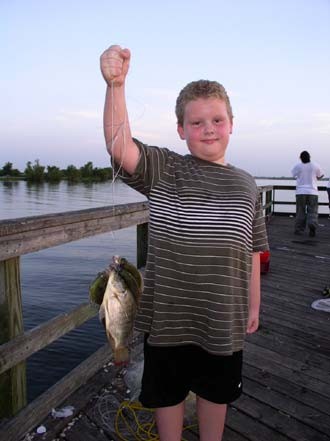| Daniel Steele accompanied his grandfather, Bill Rohm, to one of the piers at Calaveras Lake last week. Between himself, his grandfather, and cousins Aaron and Adrian Treviño, they caught a nice string of pan fish, including tilapia and bull brim, or bluegill. The fishing party planned to donate the fish to a family that was encamped on the shore of the lake. They also talked about plans to fish for gafftop in Port Aransas this weekend. (Photo by Michael Cary) |
Jesse Granado learned how to fish with his Uncle Rafael. They used to sit under a Cypress tree downstream from "the Pioneer," throw lines into the San Antonio River, and catch catfish and bass. His lifelong friend, Michael Espinoza, once snagged a three-foot-long alligator gar in the river.
The stretch of river downstream from Pioneer Flour Mills, adjacent to the Blue Star Art Space, has long been a venue for locals who practice the art of fishing. People line the rails in Blue Star's parking lot, bait their hooks, cast lines into the water, and kick back to wait for a bite.
Jesse was there last week, accompanied by Michael, his brother Manuel, and their two sons, each named Junior. Since they were low on funds, Jesse had brought along a lump of masa harina, or flour tortilla dough, which he rolled into little balls and squeezed onto a hook. His technique produced a small tilapia, and he quickly cut it up for bait to lure a bigger fish.
|
Fish at your own risk Texas does not routinely monitor fish for mercury or other contaminants; for example, according to the Seafood Safety division of the Texas Department of Health, which is responsible for issuing advisories, fish in the San Antonio River haven't been tested since April 1998. The Texas Commission on Environmental Quality can call for the Department of Health to routinely monitor all Texas bodies of water and fish for pesticides, selenium, mercury, dioxin, PCBs, and Volatile Organic Compounds, also known as VOCs. A ban means no fish can be eaten or caught in those waters; an advisory indicates that the fish may be eaten, but only in limited amounts. The website for advisory and ban listings is www.tdh.state.tx.us/bfds/ssd. These listings include the type of fish affected, consumption advisories for children and adults, and the parts of the water bodies that are affected. Only part of the lake, river, or bay may be contaminated. Additional information and a copy of Fish Advisories and Bans is available by calling 512-719-0215. In Bexar County, one ban is in effect for Lower Leon Creek south of Hwy 90 to SW Military Drive. Last September, some fish tested as much as 15 times more than the maximum contaminant level set by the Environmental Protection Agency for PCBs. `See "Carp with a side of Arochlor," September 11-17, 2003, and "Air Force brushes off fish fuss," September 18-24, 2003`. Here are bans and advisories for other Texas waterways: Mercury advisories Upper Lavaca Bay (total ban), Lake Pruitt, Lake Kimball, B.A. Steinhagen Reservoir, Sam Rayburn Reservoir, Big Cypress Creek, Toledo Bend Reservoir, Caddo Lake, Lake Daingerfield, Ratcliff Lake, Lake Meredith, the Gulf of Mexico (the entire coast) Bans due to other compounds Trinity River (Chlordane and PCBs) Advisories due to other compounds Houston Ship Channel and Upper Galveston Bay (Dioxin) Sources: Texas Department of Health, SEED Coalition |
"You would be surprised what you can catch out of the San Antonio River," Michael said as he manipulated his small Scooby Doo-themed rod and reel. "Everybody knows the fishing hole we call 'the Pioneer."'
Some residents might be surprised to see people standing along the rails of the Blue Star parking lot, dropping baited hooks into the murky, greenish brown water, but the practice has continued for decades. Anglers fish the Medina River, where it flows underneath Roosevelt Avenue on the deep South Side. They fish the Salado Creek, where it flows through the southern sector of Fort Sam Houston, just blocks from the many headstones in the national cemetery.
One wag recalls fishing for perch in a portion of an acequia that flows through Mission Burial Park, until a funeral director took offense at the affront to those who were resting eternally in nearby mausoleums. Who would think fishing worms could be so appalling and out of place in a graveyard?
Jesse and the Espinoza clan are among the few who fish in the San Antonio River who eat what they catch. Many others harbor an attitude that the fish in the San Antonio, or the Salado - and surely Leon Creek, since an actual advisory was issued - are tainted with toxic chemicals, and therefore inedible.
"The majority of fishermen are headed to the lakes," says Fred Cosper, who tends bar during the day at Leon's Ice House at the corner of Rigsby and W. W. White, where various kinds of fishing tackle and bait are sold. Cosper says people fish in the Salado Creek in Comanche Park, but mostly they go to Calaveras and Braunig lakes, fish in numerous private stock tanks, or go to the Coast. He says he would not eat fish from the local rivers and creeks. "You don't know what's in that water anymore."
Local anglers seem to have greater faith in the water quality of Calaveras and Braunig lakes despite the coal-burning power plants that circulate lake water through their facilities to cool them down as they supply power to the 1.1 million residents of San Antonio.
Authorities have for many years stocked the lakes with redfish and other species. The lakes are also home to various types of catfish, tilapia, striped bass, bluegill, and other fish that are considered top-drawer for a family fish fry.
The San Antonio River Authority has added sheltered picnic tables with barbecue pits along Calaveras Lake's shoreline. The entry fee is $4 per adult for a 24-hour period. Camping and ground fires are allowed along the banks of Calaveras, which also offers a boat launch, boat rentals, and a convenient fish cleaning station. Braunig has a boat launch but fishermen have to find a place to clean their catch.
Registered nurse Ismael Castillo works the night shift on weekends in the emergency room of downtown's Baptist Medical Center. He relieves the stress by fishing at Braunig Lake, which is near his home in Elmendorf. "I've been fishing all my life, and they're getting harder to catch," says Ismael, who grew up fishing for 50-pound flathead and alligator gar in the Rio Grande, upriver from his hometown, Laredo.
"You can spend all day out here and catch two fish, when you used to catch two fish on two hooks," says Ismael, who was on a Monday afternoon outing with his son. "Before, we would take a pan along because we knew we would catch fish. Now, you had better bring a barbecue along."
The reds at Braunig were running slow last week, but Calaveras was the place to be. Stacey Freitag and Jordan Skloss caught three reds, lost a couple of hooks, and had thrown back a couple catches one hot weekday afternoon. Freitag quickly filleted the three they kept; the smallest measured right at the minimum 20-inch length limit. The reds in Calaveras don't reproduce, so there is no limit on the bigger sizes, unlike those caught at the Coast, which must be released if they are more than 28 inches unless you receive a special tag with your fishing license.
Fishing success depends on the individual angler, whether one is out in a boat, standing on a fishing pier, or fishing from a bank. Some, like Ismael, might just be just waiting for their luck to change.
Then there are folks like Jeff Snyder, who has served as a fishing guide on Calaveras for the past 18 years. He operates Southwest Charters, which for $180 will take a party of five out for a four-hour trip. "When the sun is going down, the fish will rise, and feed uphill," Snyder says. "Shad is the key. Use cast nets to catch bait. The main bite in the accessible water is from late February to the first of November. This is like a giant aquarium. Fish grow 10 months out of the year."
Snyder apparently knows what he is talking about. He had just cleaned and filleted 25 reds for several happy clients who had spent the past couple of hours in the middle of Calaveras Lake, reeling them in, one after another. •
How to Clean Your Own Fish
Or, "Ugh, can't we just buy one at Central Market?"
By Santiago Hemingway
"The problem with cleaning a fish," my friend's uncle used to tell him, holding the frantically wriggling catch aloft, " is that you've got to get his attention first." Then he'd firmly bop the poor bass on the head with a little billy club that he carried for just that purpose. Which is to say, catching and cleaning fish is brutish work, no matter how bucolic and relaxing the fish & game shows make it look.
There are a number of ways to prepare a fresh catch for dinner; all of them require you to touch it. Fillets are the most versatile and popular method, but they also take the most practice to get right. In all cases you need a sharp knife and a tolerance for mushy, fragrant things.
Rinse off your fish, preferably in cold, running tap water.
If you plan to leave the skin on the fish, you may need to remove the scales. Clip or cut away the side fins, removing the hard surface immediately around them. Lay the fish on its side and, holding the dull blade of the knife perpendicular to it, scrape in short strokes toward the head. If large, flat, translucent flakes begin to come off, continue scraping until all of the scales are removed on both sides. Rinse the fish again.
Remove the entrails, which are nothing like the entrails of, say, cattle, but can be graphic in their own small way. Using the sharp edge of your knife, insert the blade into the belly of the fish below the gills, and cut straight back to the small vent (yes, "vent" is the polite term) by the tail. Reach into the rib cage cavity and pull out the innards. Rinse again, and, using your finger or another implement, scrape away the blood vein that runs along the backbone and wash the fish one more time.
Many people remove the head at this point, but it also makes a convenient handle for the next steps. Remove the dorsal (that is to say, "backside") fin, by cutting around it and pulling on it with a pair of pliers or a fancy fish tool.
Lay the fish flat on its side again, and cut towards the backbone at the first fleshy spot behind the gills, angling slightly toward the tail. When you hit the backbone, turn the knife so that it is flat against it and begin to saw gently toward the tail, working around the rib cage. When you get to the tail, leave a small portion of the fillet attached, gently reassemble your fish, and flip him over. Repeat the process, and then sever the fillets from the tail.
Finally, remove the skin if you prefer. Starting at the tail, saw gently between the skin and the flesh. On larger fish, stop three or four inches down and cut a small hole in the skin. Use this as a handle while you remove the rest of the skin.
Grill, broil, panfry or otherwise enjoy! •

















